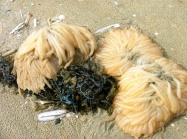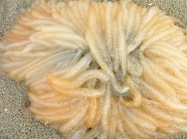MolluscaBase taxon details
Loliginidae Lesueur, 1821
Pickfordiateuthidae G. L. Voss, 1953 · unaccepted > junior subjective synonym
- Genus Afrololigo Brakoniecki, 1986
- Genus Alloteuthis Wülker, 1920
- Genus Camptoteuthis Ikegami, Y. Takeda, Mutterlose & Iba, 2025 †
- Genus Doryteuthis Naef, 1912
- Genus Heterololigo Natsukari, 1984
- Genus Loligo Lamarck, 1798
- Genus Loliolus Steenstrup, 1856
- Genus Lolliguncula Steenstrup, 1881
- Genus Pickfordiateuthis G. L. Voss, 1953
- Genus Psiloteuthis Ikegami, Y. Takeda, Mutterlose, Iba, 2025 †
- Genus Sepioteuthis Blainville, 1824
- Genus Streptopteryx Ikegami, Y. Takeda, Mutterlose & Iba, 2025 †
- Genus Uroteuthis Rehder, 1945
- Genus Acrololigo Grimpe, 1921 accepted as Alloteuthis Wülker, 1920
- Genus Acruroteuthis S. S. Berry, 1920 accepted as Alloteuthis Wülker, 1920 (synonym)
- Genus Aestuariolus Alexeyev, 1992 accepted as Uroteuthis (Aestuariolus) Alexeyev, 1992 represented as Uroteuthis Rehder, 1945
- Genus Chondrosepia Rüppell & Leuckart, 1828 accepted as Sepioteuthis Blainville, 1824 (synonym)
- Genus Loliolopsis S. S. Berry, 1929 accepted as Lolliguncula (Loliolopsis) S. S. Berry, 1929 represented as Lolliguncula Steenstrup, 1881
- Genus Photololigo Natsukari, 1984 accepted as Uroteuthis (Photololigo) Natsukari, 1984 represented as Uroteuthis Rehder, 1945
- Genus Pteroteuthis Ehrenberg, 1831 accepted as Loligo Lamarck, 1798
- Genus Teuthis J. G. Schneider, 1784 accepted as Teuthis (Acroteuthis) S. S. Berry, 1913 accepted as Alloteuthis Wülker, 1920 (Invalid: junior homonym of Teuthis Linnaeus, 1767; placed on Official Index by ICZN Opinion 233)
marine, fresh, terrestrial
Not documented
Description Shape variable from short and stout to long and slender. Fins terminal or marginal, but always united posteriorly;...
Description Shape variable from short and stout to long and slender. Fins terminal or marginal, but always united posteriorly; funnel-locking apparatus a simple, straight groove. Eyes covered with transparent skin (corneal membrane); buccal connectives attached to ventral borders of fourth arms; 7 buccal lappets supplied with small suckers (except in Lolliguncula and Alloteuthis); 8 arms and 2 tentacles around mouth; 2 rows of suckers on arms and 4 rows on tentacular clubs, hooks never present. Usually the left arm of the IV (ventral) pair is hectocotylized in males (used to transfer sperm packets from the male to the female); the structure of the modified portion (hectocotylus) of the arm is useful in most species as a diagnostic character (often, the suckers on the hectocotylus are reduced in size or number, or modified into fleshy papillae or flaps (lamellae), or they disappear altogether. Colour: usually reddish-brown, darker dorsally, but quite variable depending on the behavioural situation. [details]
MolluscaBase eds. (2025). MolluscaBase. Loliginidae Lesueur, 1821. Accessed at: https://www.molluscabase.org/aphia.php?p=taxdetails&id=11734 on 2025-09-12
Date
action
by
2004-12-21 15:54:05Z
created
db_admin
![]() The webpage text is licensed under a Creative Commons
Attribution 4.0 License
The webpage text is licensed under a Creative Commons
Attribution 4.0 License
original description
(of Pickfordiateuthidae G. L. Voss, 1953) Voss, G. L. (1953). A new family, genus and species of myopsid squid from the Florida Keys. <em>Bulletin of Marine Science of the Gulf and Caribbean.</em> 2: 602-609. [details]
taxonomy source Vecchione M., E. Shea, S. Bussarawit, F. Anderson, D. Alexeyev, C.-C. Lu, T. Okutani, M. Roeleveld, C. Chotiyaputta, C. Roper, E. Jorgensen and N. Sukramongkol (2005) Systematics of Indi-West Pacific loliginids. <i>Phuket Marine Biological Center Research Bulletin</i> 66: 23–26., available online at https://projects.dmcr.go.th/dmcr/fckupload/upload/44/image/FullpaperPMBC/2005%20Vol.66%20Veechione%2023%2026.pdf [details]
basis of record Vecchione, M.; Brakoniecki; T.F.; Natsukari, Y.; Hanlon, R.T. (1998). A provisional generic classification of the family Loliginidae. Pp. 215-222, in: Voss N.A., M. Vecchione, R.B. Toll & M.J. Sweeney, eds (1998) Systematics and biogeography of cephalopods. <em>Smithsonian Contributions to Zoology.</em> 586: volume 1: 1-276; volume 2: 277-599. [details]
additional source Jereb, P., Vecchione, M. & Roper, C.F.E. (2010). Family Loliginidae. <i>In</i> P. Jereb & C.F.E. Roper, eds. <i>Cephalopods of the world. An annotated and illustrated catalogue of species known to date. Volume 2. Myopsid and Oegopsid Squids</i>. FAO Species Catalogue for Fishery Purposes. No. 4, Vol. 2. Rome, FAO. pp. 38-117., available online at http://www.fao.org/docrep/014/i1920e/i1920e.pdf [details]
identification resource Lu, C.C. & Chung, W.S. (2017). <em>Guide to the cephalopods of Taiwan</em>. National Museum of Natural Science, Taichung, Taiwan, 560 pp. ISBN 978-986-05-2569-4.
page(s): 222 [details]
taxonomy source Vecchione M., E. Shea, S. Bussarawit, F. Anderson, D. Alexeyev, C.-C. Lu, T. Okutani, M. Roeleveld, C. Chotiyaputta, C. Roper, E. Jorgensen and N. Sukramongkol (2005) Systematics of Indi-West Pacific loliginids. <i>Phuket Marine Biological Center Research Bulletin</i> 66: 23–26., available online at https://projects.dmcr.go.th/dmcr/fckupload/upload/44/image/FullpaperPMBC/2005%20Vol.66%20Veechione%2023%2026.pdf [details]
basis of record Vecchione, M.; Brakoniecki; T.F.; Natsukari, Y.; Hanlon, R.T. (1998). A provisional generic classification of the family Loliginidae. Pp. 215-222, in: Voss N.A., M. Vecchione, R.B. Toll & M.J. Sweeney, eds (1998) Systematics and biogeography of cephalopods. <em>Smithsonian Contributions to Zoology.</em> 586: volume 1: 1-276; volume 2: 277-599. [details]
additional source Jereb, P., Vecchione, M. & Roper, C.F.E. (2010). Family Loliginidae. <i>In</i> P. Jereb & C.F.E. Roper, eds. <i>Cephalopods of the world. An annotated and illustrated catalogue of species known to date. Volume 2. Myopsid and Oegopsid Squids</i>. FAO Species Catalogue for Fishery Purposes. No. 4, Vol. 2. Rome, FAO. pp. 38-117., available online at http://www.fao.org/docrep/014/i1920e/i1920e.pdf [details]
identification resource Lu, C.C. & Chung, W.S. (2017). <em>Guide to the cephalopods of Taiwan</em>. National Museum of Natural Science, Taichung, Taiwan, 560 pp. ISBN 978-986-05-2569-4.
page(s): 222 [details]
 Present
Present  Inaccurate
Inaccurate  Introduced: alien
Introduced: alien  Containing type locality
Containing type locality
Unreviewed
Description Shape variable from short and stout to long and slender. Fins terminal or marginal, but always united posteriorly; funnel-locking apparatus a simple, straight groove. Eyes covered with transparent skin (corneal membrane); buccal connectives attached to ventral borders of fourth arms; 7 buccal lappets supplied with small suckers (except in Lolliguncula and Alloteuthis); 8 arms and 2 tentacles around mouth; 2 rows of suckers on arms and 4 rows on tentacular clubs, hooks never present. Usually the left arm of the IV (ventral) pair is hectocotylized in males (used to transfer sperm packets from the male to the female); the structure of the modified portion (hectocotylus) of the arm is useful in most species as a diagnostic character (often, the suckers on the hectocotylus are reduced in size or number, or modified into fleshy papillae or flaps (lamellae), or they disappear altogether. Colour: usually reddish-brown, darker dorsally, but quite variable depending on the behavioural situation. [details]
| Language | Name | |
|---|---|---|
| Chinese | Qiāng-Yóu-Kē | [details] |
| Dutch | pijlinktvissen | [details] |
| Swedish | kalmarer | [details] |



